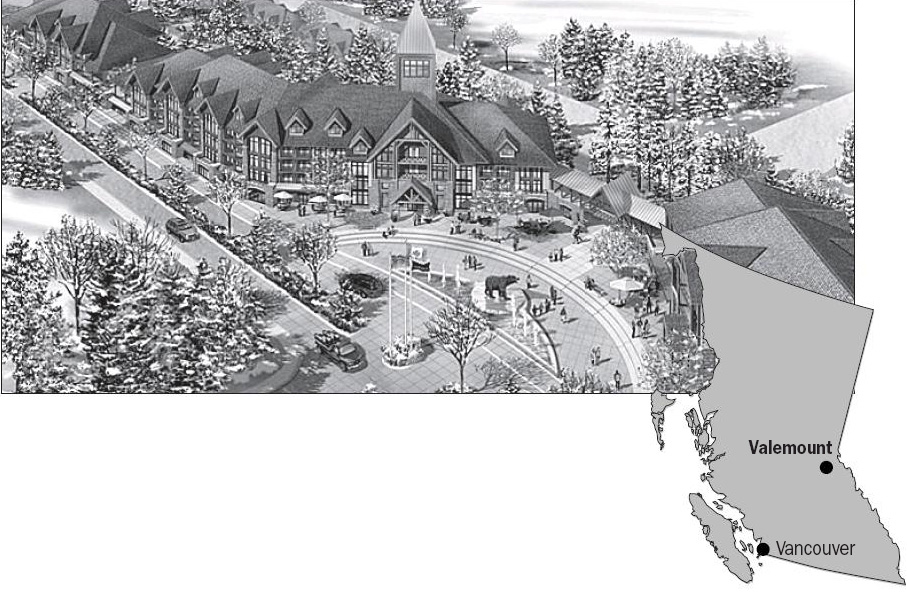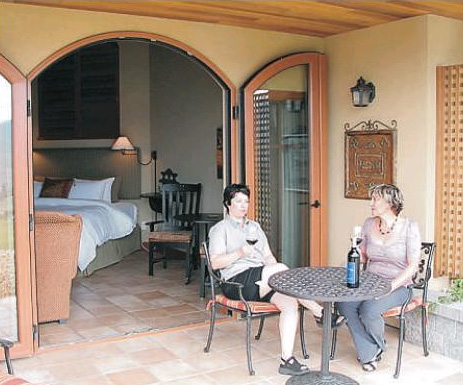Bruce Constantineau
Sun
OLIVER – Wine lovers and would-be connoisseurs don’t want to just visit their favourite Okanagan wineries any more.
Many want to stay on the properties a few days, stroll around the vineyards and generally soak up the ambience. So, winemakers are quickly becoming mini-hoteliers.
In the past two years, popular B.C. wineries like Burrowing Owl, Hester Creek and Mission Hill have invested millions of dollars adding guesthouses and villas to their properties.
Others are considering similar moves to cash in on the agri-tourism boom gripping the Okanagan Valley.
“We wanted to attract more people to our winery, and to get them here, you really need nice places for them to stay,” Hester Creek Estate Winery hospitality manager Lee Ann Openshaw said in an interview. “There is almost nowhere in Oliver now other than older motels, and some people don’t want to stay in those kinds of places.”
The newest products are clearly aimed at upscale customers, with Burrowing Owl rooms going for $350 a night during the current high season, while Hester Creek charges $305 a night.
Openshaw said three Alberta couples recently stayed in the villas, two of whom drove up in Porsches while the third drove a Ferrari.
Hester Creek spent about $2.5 million last summer to open its six Mediterranean-style villas, which offer outstanding wine country views, fireplaces, soaker tubs, walk-in showers and geothermal heating and cooling.
Agri-tourism accommodation is permitted on Agricultural Land Reserve property if the projects are restricted to 10 sleeping units and the total developed area takes up less than five per cent of the land parcel.
Burrowing Owl proprietor Midge Wyse said she and her husband, Jim, had a grand vision for the wine property when they acquired it in 1993. That vision included a fine-dining restaurant and a high-end guesthouse in a part of B.C. that clearly wasn’t used to such facilities.
A wine bar and restaurant — The Sonora Room — opened in 2003 and a 10-unit guesthouse opened 18 months ago.
“We’ve travelled the world and stayed in vineyards and eaten in beautiful restaurants and there was absolutely nothing like it here,” Wyse said. “There was a real void.”
She said local residents told them people would never pay high-end prices for fine dining or $300-plus-a-night for upscale accommodation. But they were wrong on both counts.
Wyse said the restaurant attracted tremendous business as soon as it opened and the guesthouse is practically full all summer. She said guesthouse detractors pointed to all the competition it would face from motels in Oliver and Osoyoos.
“This is a totally different market than the motels,” Wyse said. “What we have here is gorgeous scenery, beautiful wine and the best food in the Okanagan in our restaurant. So we’re not worried about the motels.”
She said only one guest has ever complained the rates were too high and noted many travel agents have told her the rates are low for the product they offer.
Wyse — who hates the term “Napa North” because the Okanagan has its own distinct character — feels the region continues to attract lots of new condominium and time-share developments. But she said the number of new related services, especially restaurants, has not kept pace.
“Maybe it’s tough to make a year-round business because things can still be a little lean in the winter here,” Wyse said.
Mission Hill Family Estate winery in Kelowna has dipped its toes in the guesthouse market this year by opening The Lake House on Green Bay, a four-suite building with upscale accommodations on the shore of Okanagan Lake, a few minutes down the road from the wine property itself.
Mission Hill marketing and guest services manager Ingrid Dilschneider said the new facility is a natural progression for Mission Hill.
“We built it to provide an extended experience in wine country — something to entice a certain clientele we get here,” she said. “There are some high-end resorts around but not a lot of smaller upscale guesthouses that provide an intimate experience.”
But Mission Hill has even grander accommodation plans for a seven-hectare land parcel adjacent to its vineyards.
Dilschneider said the project is in the early planning and approval stage now and is probably three or four years away from becoming reality. But it’s ambitious and not located on ALR property so it’s not restricted to a maximum of 10 suites.
Early plans call for an inn — or auberge — with 80 to 120 rooms, 12 to 20 townhouses, a wellness centre, a conference centre and a restaurant.
Just down the road in nearby Quails’ Gate winery, proprietor Tony Stewart says he’s giving serious consideration to building a new guesthouse. The winery has spent about $8 million recently on a new restaurant, wine shop, warehouse, bottling facilities and administration offices.
“We’d want to build a very small, very high-end facility that can offer visitors a really unique experience — a special place to go for an anniversary or a romantic getaway,” Stewart said.
He feels a guesthouse would help drive more business during the spring and fall shoulder seasons, when the region traditionally attracts fewer visitors.
“Having accommodation on the property would allow us to really grow that side of the business by offering things like cooking classes and demonstrations and educational events,” Stewart said.
On the sun-soaked Naramata Bench near Penticton, a 7,500-square-foot luxury log house called Apple d’or has emerged as one of the area’s highest-end wine country guesthouses.
While not located directly on a winery itself, the one-year-old facility’s location near 22 Naramata Bench wineries has made it a favourite with wine lovers. Owners Holly Stevens and Colin Moores plan to produce sparkling wine next year from Pinot Noir and Chardonnay grapes growing on the 1.25-acre former apple orchard.
The two former West Vancouver residents built the home themselves after acquiring the property in 2000 and breaking ground in 2002. The five-year construction schedule clearly wasn’t fast-tracked, but the end result has earned Canada Select’s only five-star accommodation rating in the area.
High ceilings, hardwood floors, massive beams and an immaculately landscaped backyard with a swimming pool and hot tub tell you this is no discount hostel. Two of the three Apple d’or suites go for $325 a night while the third carries a $275-a-night price tag during the summer season.
“When we told people we bought property in Naramata, they didn’t even know where that was,” Stevens said. “But now everything has just taken off here.”
Moores said property in the area that sold for $50,000 an acre seven years ago now sells for $200,000 an acre.
He said they thought the guesthouse would achieve an occupancy rate of just 25 or 30 per cent when it opened for business last year but it ended up being closer to 60 per cent.
Bad weather hurt business this spring but July and August look to be “absolutely gangbusters” this year, Moores said.
Anthony Buree, general manager and partner in Osoyoos wineries Le Vieux Pin and La Stella, said the owners hope to build luxury villas on both properties within two or three years. He envisions buildings you might see in southern France or in the Tuscany region of Italy.
“They’d have five rooms, a professional kitchen, a pool and people would rent the whole thing,” Buree said. “The clients we’re looking at are people who really want privacy and don’t want to share a place with somebody else. It’s not a bed-and-breakfast concept.”
Hospitality industry consultant Ellen Walker-Matthews feels smaller, winery-related villas and guesthouses are finding their place in the Okanagan market now as the number of larger projects appears to be slowing down.
“I think the next big trend is the culinary side of things, as more wineries with guesthouses get into cooking classes and teaching people about wine and food pairings,” she said. “That’s a huge market in Napa but it’s not really up here yet.”
© The Vancouver Sun 2008






